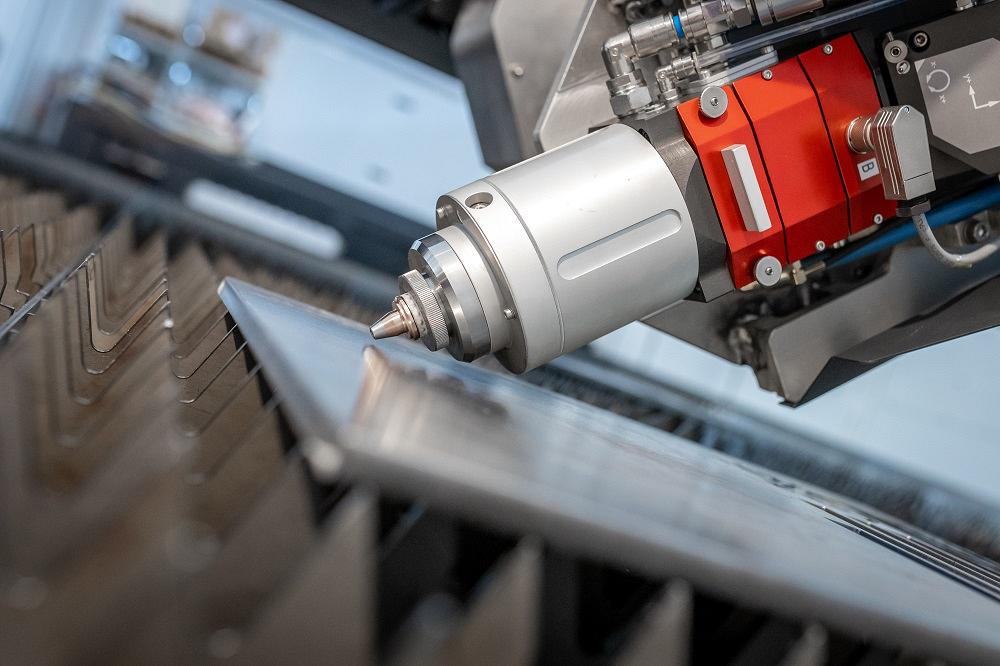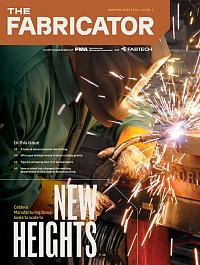Senior Editor
- FMA
- The Fabricator
- FABTECH
- Canadian Metalworking
Categories
- Additive Manufacturing
- Aluminum Welding
- Arc Welding
- Assembly and Joining
- Automation and Robotics
- Bending and Forming
- Consumables
- Cutting and Weld Prep
- Electric Vehicles
- En Español
- Finishing
- Hydroforming
- Laser Cutting
- Laser Welding
- Machining
- Manufacturing Software
- Materials Handling
- Metals/Materials
- Oxyfuel Cutting
- Plasma Cutting
- Power Tools
- Punching and Other Holemaking
- Roll Forming
- Safety
- Sawing
- Shearing
- Shop Management
- Testing and Measuring
- Tube and Pipe Fabrication
- Tube and Pipe Production
- Waterjet Cutting
Industry Directory
Webcasts
Podcasts
FAB 40
Advertise
Subscribe
Account Login
Search
How high-powered fiber lasers bevel plate
Tilting cutting head opens new application opportunities
- By Tim Heston
- January 12, 2024
- Article
- Laser Cutting
Fabricators that bevel plates work in a world of trade-offs. Thermal cutting tables with tilting heads can bevel, yet if those bevels were destined for welding, they might require a secondary deburring operation. And skipping that secondary operation isn’t really an option, especially if downstream joining processes like robotic welding require precise weld preps.
The reason for this relates to those numerous trade-offs that determine how precise a cut edge really is. Heat-sensitive material might be sent to the waterjet table. Some plates requiring ultraprecision beveled edges might be plasma cut, then sent through a secondary machining process. For less precise work, a conventional deburring machine might suffice.
Andrea Falaschi, worldwide export sales manager for laser cutting machine manufacturer Cutlite Penta, an Italian company with U.S. offices based near Atlanta, recalled working with European fabricators several years ago. All shared a common conundrum.
“Edges with dross add more time and money,” Falaschi said. “Fabricators wanted to cut plate and then go right to the welding robot.” They wanted to bevel with the laser, yet the effort really wouldn’t make economic sense without a perfectly cut edge. If plates needed to be brought to a secondary edge-finishing operation anyway, plasma cutting was simply more cost-effective.
That’s the traditional trade-off in the precision plate cutting and beveling arena: Spend more time and money upfront with cutting (with waterjet or machining) and less on secondary operations like grinding. Alternatively, you spend less on thermal cutting and more on those secondary operations. New laser cutting technology, however, is starting to alter those trade-offs.
It’s not just about laser power, either. Sure, ultrahigh-power fiber lasers—20, 30, 40, and now 50 kW—can certainly cut through thick plate quickly, but the kilowattage alone is just one piece of the puzzle. Those high-powered lasers need beam delivery systems, cutting head designs, and lens technologies capable of handling immense laser power in harsh industrial environments. Just as important has been gas mixing technology, with most plate cutting setups nowadays using a nitrogen assist gas with a dose of oxygen.
Then there’s the design of the cutting head itself. This includes effective beam and assist gas delivery and, for beveling, a head design that’s compact enough to tilt over a minimal footprint—that is, the clearance the head needs to perform a bevel. More clearance requires a wider web (uncut section) near the plate edge, which can lead to some costly scrap.
Tying it all together, Falaschi said, is software, with algorithms determining how to modulate laser cutting power and the gas mix, as well as the best cutting path, speed, and rate of acceleration around specific shapes to create the cleanest kerf possible.
“We started our R&D effort about seven years ago,” Falaschi said, “and built our first generation of our bevel cutting head. To be honest, it was quite complicated, and it had a large footprint. But it was a promising beginning.”
He added that the company’s latest iteration addresses all those challenges. First is the small footprint, made possible by a cylindrical laser cutting head manipulated not by an articulating robot but by a 5-axis Cartesian system attached to the gantry. The nozzle itself is a narrow cone, giving the needed clearance for a bevel angle up to 45 degrees. The head moves along several axes, which reduces the footprint below the head.
The entire motion system, Falaschi said, is designed to ensure precise positioning, which becomes especially important as laser powers rise. Specifically, the tilting action must keep the cutting tip in the same Z position, maintaining a consistent standoff between the plate surface and nozzle tip. That control helps manage other variables, like ensuring good laminar flow of assist gas as the head tilts from 0 to 45 degrees.
Complexities of the Tilt
Bevel cutting’s other challenge is its complexity, especially with the laser. Again, in many cases, bevel cutting thick plate with a fiber laser really only makes economic sense if the cut plate can be sent directly downstream to welding or the next primary operation. Spend extensive time deburring a beveled edge (or any edge in thick material, for that matter), and the speed advantage of even an ultrahigh-powered fiber laser can go away.
Every time the head tilts, the material’s thickness and overall cutting characteristics change. This might require a slightly adjusted gas mix, such as a bit more oxygen, a different travel speed, a change in laser power, or numerous other variables. The goal is to maintain laminar flow of assist gas around the beam even as the head tilts and the cut thickness grows.
“We developed our own gas mixing technology that’s under digital control,” Falaschi said. “We don’t open or close valves or modulate the amount of oxygen and nitrogen manually. It’s all managed through software.”
Along with lens technology, gas mixing has been a key enabling technology for ultrahigh-powered fiber lasers. The inert nitrogen in the assist gas stream evacuates molten metal in the kerf to leave a clean-cut edge, while a low percentage (up to about 5%) of oxygen provides the chemical reaction needed to leave no dross behind.
As Falaschi explained, dynamically controlling the assist gas mix has helped make bevel cutting possible. Still, this again is just a piece of the puzzle. Software algorithms also control the cutting speed through contours to ensure consistent energy and heat buildup. It also needs to modulate the laser power, especially as the cutting head nears the plate edge.
“If you cut close to the edge of the plate, you need to calculate the space you have between the material bottom and the frame of the machine,” Falaschi said. “Again, we’re working with 30 kW or more of laser power. You cut vertically, and you have the graphite underneath the cutting bed. But when you cut at 45 degrees and approach the edge of the machine, you need to modulate the laser power. Otherwise, you could cut through the frame of the machine.”
It’s a balancing act. A 30-kW (or greater) laser modulated to a lower power cutting thicker material (because of that 45-degree bevel) requires a dialed-in cutting speed—not too slow, but not too fast either. “If you cut too quickly, you don’t remove the dross,” Falaschi said. “But if you slow down too much, you melt too much material and create serious issues with edge quality, especially when you’re beveling at an angle of 30 degrees or more.”
Watch the bevel cutting laser head in action and you can see why software is such a critical piece of the puzzle. The head performs a pierce, then cuts a lead-in as it tilts to a designated angle to commence the bevel cut. To create a bevel with a land (vertical section) for a weld prep, it might cut vertically first for the land and then tilt for the bevel—or vice versa. It all depends on the bevel angle required and where the cut occurs during the part profile’s cutting sequence—all optimized to control heat and mitigate any material distortion. Additional variables come into play when rounding beveled corners, changing the beveled angle during the cut, or creating a beveled hole (like a countersink).
“When we move in an arc, the acceleration must be constant to ensure the laser cutting characteristics remain optimized around those corners and contours,” Falaschi said.
Cut Quality Factors
Software is also needed to control the quality level, which can affect part cost. “Some fabricators dial in different quality levels,” Falaschi said, adding that higher cut quality can have a higher part cost. Not every job requires incredibly high edge quality, and software can adjust cutting parameters to account for this.
Falaschi added that “quality” here is relative. Fiber laser cut edge quality remains very high. They all could be classified as “precision” cuts; there are just different degrees of precision. Some jobs involve extremely tight tolerances and high-quality material that might have had machined edges in the past; now, these jobs can skip the machining center and just be bevel cut on the laser. Such jobs might utilize material with very flat, clean surfaces.
Conversely, other jobs still require a good edge, but they utilize less expensive material, and edge tolerance requirements aren’t quite as stringent. In these cases, software helps programmers adjust the parameters (like assist gas usage) to ensure those per-part costs remain low.
All this proves that bevel cutting thick plate with a fiber laser isn’t a straightforward affair. Cutting still boils down to per-part cost, and for many applications, legacy processes like plasma cutting aren’t going anywhere. That said, the higher power levels entering the laser cutting arena bring new application opportunities. What once was plasma cut or even machined now can be bevel cut by an extraordinarily powerful, and highly optimized, beam of light.
About the Author

Tim Heston
2135 Point Blvd
Elgin, IL 60123
815-381-1314
Tim Heston, The Fabricator's senior editor, has covered the metal fabrication industry since 1998, starting his career at the American Welding Society's Welding Journal. Since then he has covered the full range of metal fabrication processes, from stamping, bending, and cutting to grinding and polishing. He joined The Fabricator's staff in October 2007.
subscribe now

The Fabricator is North America's leading magazine for the metal forming and fabricating industry. The magazine delivers the news, technical articles, and case histories that enable fabricators to do their jobs more efficiently. The Fabricator has served the industry since 1970.
start your free subscription- Stay connected from anywhere

Easily access valuable industry resources now with full access to the digital edition of The Fabricator.

Easily access valuable industry resources now with full access to the digital edition of The Welder.

Easily access valuable industry resources now with full access to the digital edition of The Tube and Pipe Journal.
- Podcasting
- Podcast:
- The Fabricator Podcast
- Published:
- 04/16/2024
- Running Time:
- 63:29
In this episode of The Fabricator Podcast, Caleb Chamberlain, co-founder and CEO of OSH Cut, discusses his company’s...
- Trending Articles
Tips for creating sheet metal tubes with perforations

JM Steel triples capacity for solar energy projects at Pennsylvania facility

Are two heads better than one in fiber laser cutting?

Supporting the metal fabricating industry through FMA

Omco Solar opens second Alabama manufacturing facility

- Industry Events
16th Annual Safety Conference
- April 30 - May 1, 2024
- Elgin,
Pipe and Tube Conference
- May 21 - 22, 2024
- Omaha, NE
World-Class Roll Forming Workshop
- June 5 - 6, 2024
- Louisville, KY
Advanced Laser Application Workshop
- June 25 - 27, 2024
- Novi, MI



























